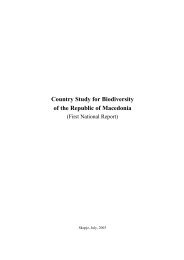CBD Fourth National Report - Azerbaijan (English version)
CBD Fourth National Report - Azerbaijan (English version)
CBD Fourth National Report - Azerbaijan (English version)
You also want an ePaper? Increase the reach of your titles
YUMPU automatically turns print PDFs into web optimized ePapers that Google loves.
3.1. Use and values of biodiversity<br />
Country Study on Biodiversity and <strong>Fourth</strong> <strong>National</strong> <strong>Report</strong><br />
The Republic of <strong>Azerbaijan</strong><br />
Biodiversity has significance to mankind in a range of ways, which may be economic or<br />
intrinsic. Biodiversity in <strong>Azerbaijan</strong> is used directly in a large number of ways, and in<br />
addition a range of cultural and aesthetic values are placed on species and ecosystems in the<br />
country.<br />
3.1.1. Agrobiodiversity<br />
In general, the Caucasus region is recognized as an important centre of origin for<br />
agrobiodiversity. Within this context <strong>Azerbaijan</strong> supports a number of wild relatives and<br />
varieties important for agriculture. The cereals and livestock varieties are particularly<br />
significant.<br />
3.1.1.1. Crops under cultivation<br />
Cereals<br />
Of 454 species of gramineous plants (Poaceae) in <strong>Azerbaijan</strong>, 25 are cultivated. <strong>Azerbaijan</strong><br />
is one of the centres of origin for cereal crops, and shows<br />
Picture<br />
particular variety in the forms of wheat described. Some<br />
species of wheat are particularly important for agriculture,<br />
including so-called ‘tough wheat’ (Triticum durum) of<br />
which 43 varieties are described from <strong>Azerbaijan</strong>, and ‘soft<br />
wheat’ (T. aestivum), which is represented by at least 87<br />
varieties, including a range of hybrid types. Although a<br />
range of native varieties of wheat have been developed over<br />
time, more recently a number of forms have been<br />
introduced associated with more intensive agricultural systems.<br />
Other forms of cereals found in <strong>Azerbaijan</strong> include barley (Hordeum spp.), rye (Secale spp.),<br />
triticale (Triticale spp.), maize (Zea spp.) and rice (Oruza spp.). Ten species of barley have<br />
been recorded from <strong>Azerbaijan</strong>, of which two are cultivated (of which 500 genetic varieties,<br />
including a number of native forms, have been described) while five species of rye occur,<br />
although only one of these (Secale cereale) is cultivated. Only one species of maize is widely<br />
grown in <strong>Azerbaijan</strong> (Zea mays), and 90 distinct genetic varieties are registered. Similarly<br />
although only one species of rice is grown in <strong>Azerbaijan</strong> (Oryza sativa), over 80 local<br />
varieties have been registered, including a number of traditional cultivars. In the case of<br />
triticale (a hybrid of wheat and rye) 326 varieties have been described.<br />
A wide range of other crops are grown in <strong>Azerbaijan</strong>, including vegetables, potatoes, vines,<br />
fruit, tobacco, tea and cotton.<br />
Horticulture<br />
A range of wild plants are widely cultivated in gardens, with domesticated varieties of fruits<br />
and berries having been developed from wild relatives, including apples, pears, walnuts,<br />
hazelnuts, blackberries, medlar and others. Over 6000 fruit and berry samples of 150 species<br />
are cultivated, many in a range of local forms including notably apricots (Armeniaca<br />
vulgaris), cherries (Serasus spp.), pomegranates (Punica granatum) and grapes (Vitis<br />
vinifera).<br />
Wheat, barley and sweetcorn are currently the main crops grown in the Nakhichevan<br />
Autonomous Republic, with wheat being the most extensive crop (both ‘tough’ (durum<br />
72<br />
2009

















